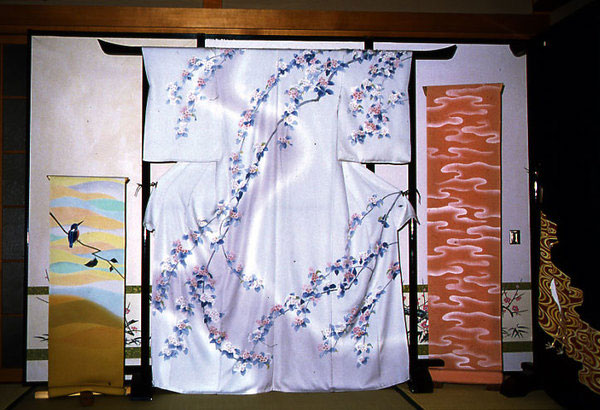
- Dyed textiles
- Aichi
Nagoya textiles Nagoya yuzen
Beauty of quiet colors and austere elegance
A long tradition of exquisite patterns
Description
What is Nagoya textiles ?
Nagoya yuzen is a cloth that is dyed and painted through a range of traditional techniques that are unique to the city of Nagoya, Aichi prefecture.
The designs used for this craft range from monochromatic, color gradation, or classical motifs, but they all have a minimal palette of simple colors in common. Differing from beautiful Kyo yuzen or graceful Kaga yuzen, Nagoya yuzen's appeal is from muted and elegant designs.
There are three dyeing techniques, each with their own array of traditional skills and effects. Nagoya tegaki yuzen involves drawing designs by hand onto the fabric while Nagoya kata yuzen uses Ise katagami, dyeing paper stencils originally from Ise. The third technique, kuromontsuki-zome, is the dyeing of family crests in black and usually meant for formal or ceremonial clothing. Today, this craft has tastefully combined not only the traditional elegance but also more contemporary tastes to give a fresh modern appearance.
History
The origin of Nagoya yuzen dates back to about 1730-1739. At that time, there was an opulent culture in the Owari domain (modern day Nagoya), which attracted craftsmen from all over Japan including dyers from Kyoto and Edo (modern day Tokyo). These artisans are thought to have brought Yuzen dyeing techniques to the region. However, with the overthrow of the lord, Muneharu TOKUGAWA, the culture of the domain became simple and frugal, leading to the current austere elegance of the craft.
Although Nagoya yuzen is well known today, the term Nagoya yuzen only came to use in 1983., formerly having been included under the Kyo yuzen umbrella. In 1983, the Nagoya Yuzen Kuromontsuki Federation of Cooperatives was established by three organizations; the Aichi Prefecture Dyeing Cooperatives of Kuromontsuki-zome dyers, the Aichi Prefecture Custom-made Dyeing Cooperatives for Komon and Kata Yuzen dyers, and the Nagoya Yuzen Industrial Cooperatives of Tegaki Yuzen dyers. In April of the same year, Nagoya yuzen was designated as one of the National Traditional Crafts.
General Production Process
- 1. Rough draft
The design and colors are decided, a draft is created on paper, and a solution made from the juice of dayflower, which disappears when wet, is used to transfer the design onto fabric. A modern synthetic version of this solution is sometimes used as it disappears when the fabric is steamed.
- 2. Starching
Itome-nori is a starch glue mix made of zinc dust, glutinous rice powder, and rice bran, and is spread onto the reverse side of the fabric to prevent dyes absorbing in the later steps. This is a method unique to Nagoya yuzen. Besides starch glue, a mixture made from ultramarine blue pigment called gunjo and glutinous rice powder is sometimes used. Unlike the starch glue, which is water soluble, the pigment and rice powder mixture can only be removed with benzine.
- 3. Coloring
Based on the rough draft, dyes are applied in the order of lightest to the darkest with multiple types of painting brushes and wide brushes to cover larger areas. Between applying dyes, the reverse side is repeatedly dried over a hot plate to prevent the starch glue from becoming soaked and colors from mixing. After the fabric is steamed in a later process, the colored dye application is complete. However, finer detail are dyed in a later process.
- 4. Sizing
Steamed glutinous rice powder mixed with salt is applied to the patterns to prevent ground colors that will be applied in the following step, from bleeding into the design. Itome-nori starching is done with a narrow tube but tubes for applying the rice powder have a wider opening to cover a larger area. In addition to the rice powder mix, sawdust or rice bran is sprinkled on the fabric to speed up drying and avoid the mix from spreading. This process also prevents dye migration in the later steps.
- 5. Ground dyeing
The base colors are chosen and applied by referring to color samples and cloth swatches. Mixing too much color decreases the luminosity and brightness of the target color, so it is important to prepare with as less dye as possible. When the color is ready, it must be spread quickly across the fabric with a wide brush, for if one end dries too soon it will result in uneven coloring. This process requires a steady hand and years of practice.
- 6. Final coloring
Any fine details left out in the early steps are now filled in. Before final coloring, excess dyes and glue are washed out, followed by hand or mechanical steaming to remove wrinkles and adjust the length and width. After the last steaming, final colors and details are applied along with any gold powder or gold leaf. Some designs do not require this last process of fine coloring.
See more Dyed textiles
- Kaga textiles
- Kyo textiles
- Tokyo fine-patterned dyeing
- Nagoya textiles
- Kyo-komon textiles
- Arimatsu tie-dyeing
- Ryukyu traditional textiles
- Tokyo textiles
- Kyo dyed textiles
- Nagoya kimono-dyeing
- Kyo kimono-dyeing
- Naniwa Honzome Hand Dyeing
- Tokyo Honzome Chusen
- Tokyo Plain Dyeing
See items made in Aichi
- Tokoname ware
- Akazu ware
- Toyohashi brushes
- Nagoya textiles
- Nagoya Buddhist altar
- Owari Cloisonné
- Arimatsu tie-dyeing
- Mikawa Buddhist altar
- Seto-sometsuke ware
- Nagoya kimono-dyeing
- Nagoya traditional paulownia chest
- Okazaki stonemasonry
- Nagoya Sekku Kazari
- Owari Buddhist altar equipment
- Sanshu Onigawara Crafts































































































































































































































































































